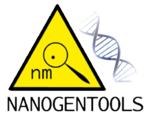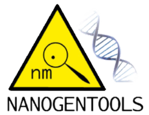[su_frame align="left"] [/su_frame]
[/su_frame]
The Università del Piemonte Orientale (UPO) is an Italian State University established in 1998. It has 7 Departments, 1 Medical School, about 11,000 students, 400 professors/researchers, 350 employees, about 160 PhD students and 100 post-docs. The recent national evaluation of research quality (July 2013, National Agency for the Evaluation of the University and Research Systems) ranks UPO among the best universities in Italy for scientific research. The UPO crucial aim is to strengthen the integration of the community in national/international networks by promoting scientific exchanges. UPO is a competent partner of the European Food Safety Authority (EFSA), the EU body for risk assessment regarding food safety. The Department of Science and Technological Innovation (DISIT) has got a large scientific background on monitoring biological effects of pollutants in different target species. DISIT has developed several research lines to study the molecular mechanisms involved in response to abiotic stress, heavy metal insults and NM exposure, using a broad integrative biology approach (from molecular systems to high orders level responses). DISIT main interest is the identification of modes of action of chemicals (including NMs) looking at gene/protein expression profiles in different species, from human to environmental models (microorganisms, fish and invertebrates).
[su_service title="Key People" icon="icon:users" icon_color="#08c" size="24" ]
Dr. Francesco Dondero, senior staff. He will coordinate the molecular systems biology training and research activity within the project. He has a broad experience in ecotoxicology: toxicity testing, data modeling, risk assessment, kinetics and toxico-dynamics of pollutants. He has more than 50 papers as author or co-author in international journals (H-index, 19), focusing recently on the environmental effects and risk of NMs. In 2014, he organized and chaired a session on nano-toxicology during SETAC conference in Basel, and an open workshop on nanoparticle mechanistic toxicology at the Univ. of Birmingham, UK. He is member of the Nanosafety Cluster and has participated in the draft of the booklet “Nanosafety in Europe 2015-2025: Towards Safe and Sustainable Nanomat. and Nanotech. Innovations”, which includes state of the art (SOA) and guidelines for future research on environmental and human nanotoxicology.
Prof. Emilio Marengo, senior staff; Prof. Marengo has more than 20 years experience in LC-mass spectrometry analysis in different matrixes. In NANOGENTOOLS he will direct the metabolomics training and research activity.
Dr. Enrico Boccaleri, senior staff; Dr. Boccaleri has 20 years experience on the synthesis of lamellar materials, and functionalization and analysis of carbon nanostructures and organosilicic molecules (polyhedral oligomeric silsesquioxanes). In this project, he will direct the material science training and research activity.
[/su_service]
[su_service title="Involvement in Research and Innovation projects" icon="icon:gears" icon_color="#08c" size="24" ]
UPO is partner of several European research and education programmes; at present it is involved in 20 FP7 Projects (2 ERC grants) and 2 H2020 Projects (1 as Coordinator).
[/su_service]
[su_service title="National projects" icon="icon:folder-open" icon_color="#08c" size="24" ]
[su_list icon="icon:caret-right" icon_color="#08c"]
- “Untargeted approach in detecting food adulteration and contamination using spectroscopic techniques database and chemometrics” PRF 2009 1511573, supported by the Italian Minister of Health (2010-2015)
- “Characterization of post-translational modifications and determination of an protein biomarker for the diagnosis of autoimmune disease by shotgun analysis of human fluid samples”, supported by ISI Foundation and ISALIT srl (2014-2015)
- “Sviluppo di nuovimetodidiagnosticitramite HPLC-MS ad altarisoluzione per l’identificazione di biomarker per le malattieautoimmuni (IMMUN-MARK)”, supported by CRT Foundation (2015-2017)
- “WATPAD – WATer impacts of PADdy environment”, supported by CARIPLO Foundation (2015-2017)
[/su_list]
[/su_service]
[su_service title="Publications and/or research/innovation products" icon="icon:book" icon_color="#08c" size="24" ]
[su_list icon="icon:caret-right" icon_color="#08c"]
- Corsi I, et al. Common Strategies and Technologies for the Ecosafety Assessment and Design of Nanomaterials Entering the Marine Environment. ACS Nano. 2014 Sep 29
- Dondero F, et al (2010). Transcriptomic and proteomic effects of a neonicotinoid insecticide mixture in the marine mussel mytilusgalloprovincialis, lam..(2010). Science of the total environment, issn: 0048-9697
- Marsano F, et al (2010). Effects of mercury on dictyosteliumdiscoideum: proteomics reveals the molecular mechanisms of physiological adaptation and toxicity. Journal of proteomeresearch, issn: 1535-3907
- Boccaleri E, et al. Comprehensive spectral and instrumental approaches for the easy monitoring of features and purity of different carbon nanostructures for nanocomposite applications. Materials Science And Engineering B-Solid State Materials For Advanced Technology, 2006, vol. 1-3, p. 72-82, ISSN: 0921-51
- Gosetti F, et al. Ultra-high performance liquid chromatography tandem high-resolution mass spectrometry study of tricyclazolephotodegradation products in water.EnvironSciPollut Res Int. 2014
[/su_list]
[/su_service]

